Not so long ago, in 1998, in the Republic of Bashkortostan, and specifically at the poultry factory of the Blagovarsky district, an experimental cross-weft was bred on the basis of the Peking breed, called the favorite.
The result of the selection turned out unexpectedly successful, since the duck breeding favorite became random, but the intermediate result exceeded all expectations. Ducks became popular both at large poultry farms and small farms. In this article, we will look at the description and characteristics of ducks favorite, let's talk about growing ducklings at home, find out what to feed and how to care.
Table of contents
Favorite breed description
The points of this cross are popularly called the Pharaoh. Another name is the blue duck. Actually, the blue duck is one of the varieties of cross favorite, but this name is firmly established for the representatives of this species. The thing is most of the favorite individuals have a rather unusual noble color from blue to deep blue with an ashy tone, but there may be ducks with white and even brown plumage.
The same can be said about the color of the beak and massive webbed feet, the shade of which will be close to the color of feathers. Beak, like the head, large size. The body is elongated, the neck is small, the keel protrudes a little, powerful, not long wings, fit snugly to the body.
The content of blue ducks at home
The favorite ducks are not afraid of high and low temperatures, they successfully acclimatize in various regions.There are no fundamental requirements for the house, which will contain blue ducks. It is desirable that birds have access to a natural reservoir. In this case, there will be no need to feed additional bait with minerals and trace elements, as the bird can find all the necessary additional food itself.
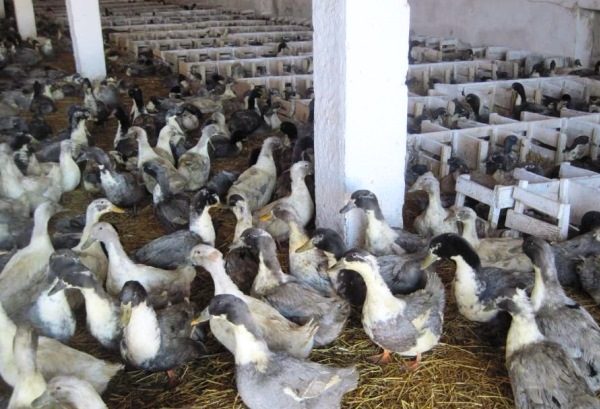
In the absence of a reservoir, ducks are kept in an ordinary house, which is not necessary to warm due to the good tolerance of the cold by the favorite. Due to the fact that these ducks are easy to breed, given their adaptive qualities, strong immunity and omnivorous, the cross is grown both in household farms and in large industrial poultry farms.
Cross characteristics
With a good fattening already in 2 months the weight of these waterfowl birds reaches about 3 kg. The weights of the adult individual are at 5 months old. The weight of the drakes on average is about 5 kg, but it can reach up to 7-8 kg with good fattening.
Females weigh less. The average weight of an adult female is about 4 kg, the maximum can reach 5-6 kg. The main advantage of a favorite is that, despite its impressive size, these ducks have very little fat unlike representatives of the same Peking breed.
Although calorie duck meat can not be called dietary, the fact of having a minimal amount of adipose tissue actively attracts the attention of consumers. The meat itself is considered very tasty, devoid of any specific smell.
In addition, excellent breeds for breeding are:
Egg production breed
It is customary to divide the ducks in four main areas.
- Meat.
- Egg.
- Egg and meat.
- Decorative.
The Pharaoh is a meat cross, but it also has good egg production, for which individual breeders tend to attribute this variety to the egg-meat direction. The number of eggs per year can be from 100 to 150, which is an excellent indicator for the meat type. Eggs are large, weighing about 80-85gr, have improved taste in comparison with chicken.
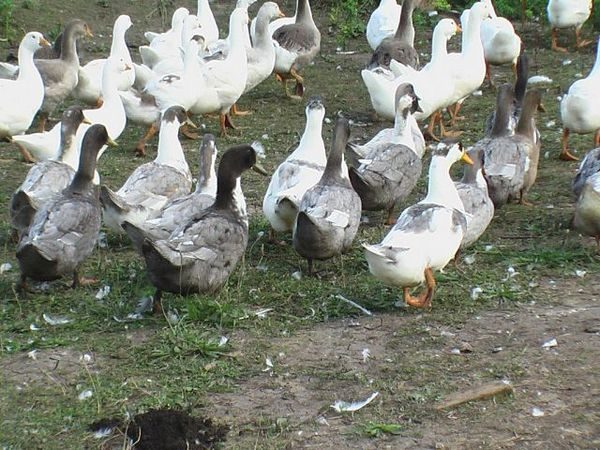
Cultivation and cultivation of blue ducklings
With all its advantages, the ducks have a blue favorite and a significant minus. This cross is almost impossible to breed naturally, using a female,since these ducks are actually completely lacking the incubation institute, although individual females successfully cope with this role, but you shouldn’t particularly rely on the mother’s feelings.
Individual farmers simply place suitable eggs on another hen ready to hatch chicks, such as goose or turkey. But if the right hen was neither among the favorite nor among other birds, it wasn’t at the compound, the eggs are simply laid in the incubator. Another breeding method is to buy ready-made daily ducklings at large poultry farms. Due to the high survival rate of ducklings, this method is very popular.
Unlike adults, kids still love the favorite warmth, therefore, having settled duck brood, in the house should create optimal temperature conditions. The first 7 days of life with the ducklings favorite should be heated from 27 to 32 degrees. Starting from the 8th day there is no need for heating, provided that the temperature of the room is above 18 degrees Celsius. To understand how correctly the temperature is chosen, it is possible by the behavior of ducklings.
When they are hot, the chicks breathe heavily with their beak ajar, often drenching with water.If the young are cold, the chicks, as a rule, squeak, trying to climb on each other, are grouped in groups in the warmest places of the perimeter. If the temperature is suitable, ducklings are mobile, move freely and rest in different zones of the allocated room.
For feeding ducklings, you can use either ready-made starting combined feeds, or use self-made feeds. Freshly hatched birds are fed a boiled finely chopped egg or cottage cheese at first.
Gradually, carrots, boiled potatoes, clover and chopped nettles are added to the food. For adolescents and adults, wet mash is made from a mixture of cereals, vegetables and root crops, greens. As special additives, birds are given bone meal, ground shells, and chalk. In the presence of a reservoir there is no need for any additives. In conditions of poultry farms and large farms, blue ducks are fattened by mixed feed.
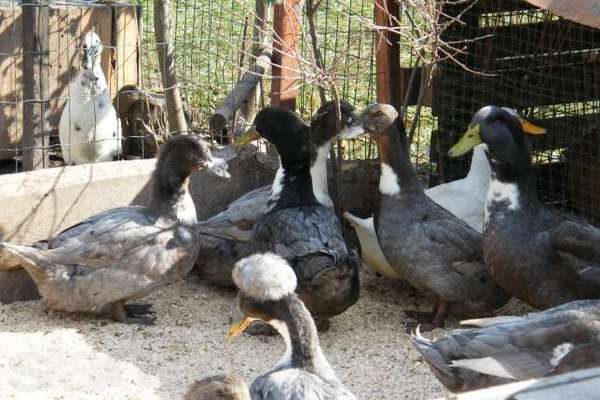
Birds consume a lot of food for the first 2 months, gaining weight intensively.After this period, feed costs are reduced, weight gain is slower.
Diseases inherent in the breed
In birds, as well as in humans, the maturation of the immune system occurs with age, so ducklings are more susceptible to morbidity than adults. Cross favorite is distinguished by low susceptibility to various diseases, however, these ducklings can also get sick, especially in the first days of life.
It is important to avoid excessive crowding. Provided that the chicks will be in the room only for the first time with the subsequent transfer, the density of the heads should not exceed 16 heads per square meter. If the ducklings have to live in the same room from the very first day before slaughter, the density of the landing should be halved.
One of the key points of successful cultivation of healthy ducklings is the availability of clean water. The ducks, being waterfowl, are ready to swim in any container with delight, so the drinkers should be installed with the expectation that the chicks cannot climb there with the intention of taking a bath. An excellent solution would be a bank turned over in a saucer.From about two weeks of age for ducklings you can put a special shallow tank for swimming.
Duck diseases can be divided into infectious and non-infectious. Non-infectious diseases include the following diseases.
- Avitaminosis. Vitamin A, E and D deficiencies are most common. With vitamin A deficiency, there is a loss of appetite, conjunctivitis, and discharge of fluid from the nasal passages, however, a number of other infectious diseases may be similar. When the diagnosis of vitamin A avitaminosis is confirmed, the affected individuals are fed with fish oil or synthetic vitamin supplements, and as a preventive measure they enrich the feed for the young with fresh or dried greens. With vitamin E avitaminosis, birds have cramps, lethargy, and weak pulse against the background of a complete lack of appetite. With a shortage of vitamin D may develop rickets.
- Liv's disease. Like vitamin deficiency, it can occur due to the scarcity of the diet on all kinds of trace elements and minerals. With their shortage, chicks pluck out their feathers and feathers, eat sawdust, soil and sand. For the treatment and prevention of used bone meal, iodized salt, crushed chalk and shells.
- Cuticle A disease of ducklings of the first month of life. Amid apathy and lack of interest in food, chicks have dark-colored diarrhea with undigested food pieces. For treatment, feeding of ducklings with a light pink solution of ordinary potassium permanganate is used.
- Omphalit. Inflammation of the umbilical ring of a non-infectious nature. As treatment, weak disinfectant solutions are used.
Infectious diseases.
- Coccidiosis Ducks most often suffer less than one and a half months. Sick individuals lose their appetite, becoming slow, apathetic. The stool is usually liquid, brown in color, interspersed with blood and mucus. Sick individuals should be destroyed, isolated from the general flock.
- Tuberculosis. Koch's wand does not spare anyone, including the ducks. The most common cause of tuberculosis is excessive crowding, dirt and stuffiness in the room in the absence of a normal ventilation system. When confirming tuberculosis of diseased ducks are slaughtered, in the house the measures of antiseptic treatment are carried out.
- Hymenolepiasis. The defeat of the intestinal tract worms. To be treated with anthelmintics. Symptoms of the disease are abnormal stools from constipation to diarrhea, convulsions, paralysis, damage to the nervous system.
- Salmonellosis. An acute form of intestinal infection caused by pathogenic microorganisms of the Salmonella genus is equally dangerous for both birds and humans. Treatment requires isolation of diseased individuals for the purpose of feeding antibacterial action with drugs, for example, tetracycline.
In addition to these diseases, ducklings can become infected with typhus or cholera. In case of typhus or cholera, treatment is not carried out - the sick bird is destroyed, the carcasses are burned, healthy individuals are quarantined for the entire duration of the incubation period.
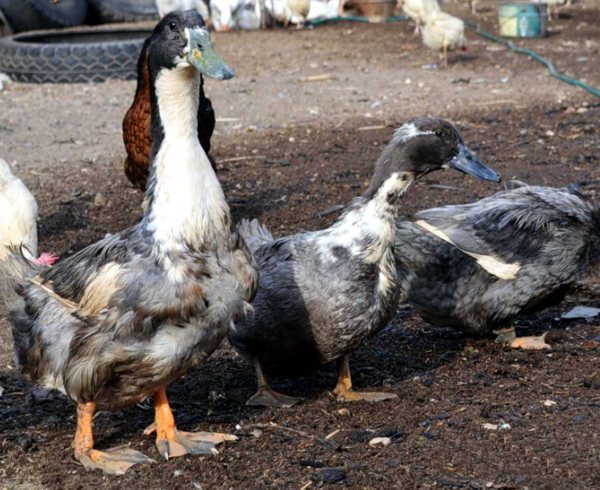
Advantages and disadvantages
Favorite or Pharaoh has a number of advantages that make this cross popular both for industrial breeding and for small farms:
- fast weight gain;
- high degree egg production for cross-country meat;
- unpretentiousness in eating;
- adaptability to different temperature conditions and conditions of detention;
- tasty meat, almost devoid of fat;
- beautifulpleasing the eye, plumage.
The disadvantages include only the negligence of ducks of this species as hens, which allows breeding birds only with the help of an incubator,hen of other breeds or through the purchase of hatched ducklings.
Reviews
Liza: This breed of ducks bred in Bashkortostan. Therefore, it is quite common with us and is in high demand. The survival rate of these ducks is 100%, although I am not an experienced poultry breeder. Immediately after the purchase, I take them off with ampicillin - 10 tablets per 3-liter jar of water (what infection could they have picked up at the poultry factory), I repeat the course a week later. I keep them for the third year. When it came to the market at a loss, whom to buy (they never had any living creatures before them), the sellers advised this breed because of its viability and unpretentiousness. Very picky about food. 50% grain and 50% bran or fodder. I follow that the feeder is always full (I feed them without measure) and clean water in the watering bowl. In addition to the main feed, they feed on grass like geese. In 2 months net weight 3-4 kg. It makes no sense to hold for more than 2 months - they won't become larger. The meat is tasty and not fat. By their nature, they are very calm and not blatant (in contrast to the neighbors of Beijing, there they make noise all day) only when they are hungry, or who will scare away. So, who else thinks to buy them or not - take it, you will definitely not regret it.
Irina: To keep ducklings of the favorite breed is very beneficial if there is a reservoir nearby. They are able to get their own food. But first they need to be fed, boiled hard-boiled eggs. Give a balanced, fortified food, for better growth and weight gain. Very good breed of ducklings for breeding.
Veronica: Very pleased with this breed. I have been breeding them for more than 3 years, while for all three years the productivity of ducks has reached up to 170 eggs per year. Highly recommend!.
Although the ducks of this cross successfully bred in large poultry farms, this bird is perfect for a small farmstead or farm due to the fact that it does not require special investments related to the arrangement of the place of deployment of ducks and the feeding of livestock.
Birds are not noisy, trusting, not to say friendly, easily settling in a new place, do not require special care efforts, despite the fact that the result of the spent effort will be meat with excellent taste and a large number (for meat cross) testicles.
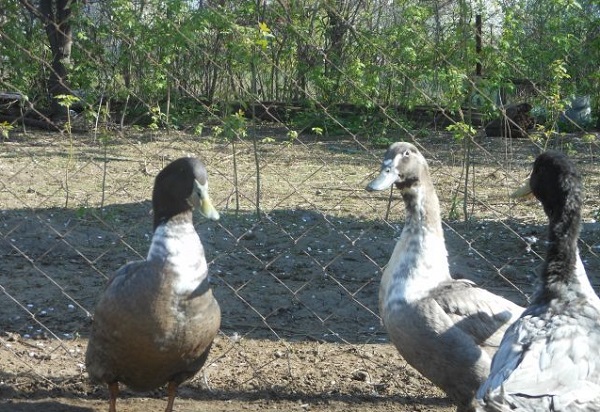
Great ducks! The main thing for ducklings is water, food, warm and dry.And then grow by leaps and bounds! In the morning you look - grown! Are these my ducks ?! at 54 days, the average weight is 2.5 kg. Gutted carcass - 1.5. But the fat in it is not enough! Left on the tribe of the most beautiful. Blue. Drakes choose a place where the duck will be carried. Not always successful. That in the bushes, somewhere else. But not in equipped nests. She carries an egg, and he walks around. Demolished, poked. Drake "took the job," poured the leaves and went to the pond. So I find two minuses. Fat they all the same. And do not hatch. Although ... let's see what happens next. Maybe they will sit on eggs, as they will be older.
Favorite blue ducks rush just like crazy, better than chickens I'm just surprised !!!